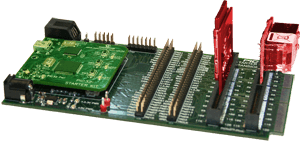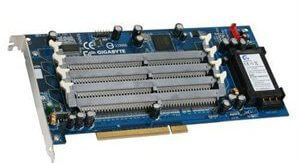An expansion board is a printed circuit board that you can insert into a computer to give it added capabilities, such as by increasing memory or improving graphics. Expansion boards are also called adapters, cards, add-ins, and add-ons.
Below there are two examples of expansion boards, one for I/O components and the other for memory expansion.
Expansion boards for PCs can be half-size (also half-length) or full-size (also full-length). Most PCs have slots for each type of board. A half-size board is sometimes called an 8-bit board because it can transmit only 8 bits at a time. A full-size board is called a 16-bit board. In addition, some expansion boards are designed to operate with a local bus, such as PCI.
In earlier PCs, all peripheral controllers were housed on expansion boards, including the disk controller, serial and parallel ports, sound, and display. Today, all the peripheral controllers may be included in the chipset.
Related Posts:
What is ExpressCard?An ExpressCard is an interface to allow peripheral devices to be connected to a computer, usually a laptop computer. ExpressCards is a hardware standard replacing PC cards or PCMCIA cards.
What is CardBus?CardBus is the latest enhancement to the PCMCIA 5.0 or later. PMCIA stands for Asociación Internacional de Tarjetas de Memoria. CardBus was introduced in 1995 and present in laptops from late 1997 onward. The main purpose of CardBus was to extend the existing PCMCIA bus to allow more powerful devices, and also provide support for 32 Bit I/O.
What is PCMCIA?PCMCIA is the short for Personal Computer Memory Card International Association. It is pronounced as separate letters. PCMCIA is also known as PC Card.
PCMCIA was originally designed for adding memory to portable computers, the PCMCIA standard has been expanded several times and is now suitable for many types of devices
What is the difference between AGP and PCI?The primary advantage of AGP over PCI is that it provides a dedicated pathway between the slot and the processor rather than sharing the PCI bus. In addition to a lack of contention for the bus, the point-to-point connection allows for higher clock speeds.
What is PCI Express?PCI Express stands for Peripheral Component Interconnect Express. It is also known as PCIe.
What is AGP Pro?AGP Pro was launched in 1998 as an AGP interface extension specification for advanced workstations. AGP Pro bus is a specification that provides a direct connection between the graphics adapter and memory.
What is AGP?AGP is the short for Accelerated Graphics Port. It was designed in 1997 as a successor to PCI type connections.
What is PCI-X?PCI-X is the short for PCI-eXtended. It was developed in 1998.


